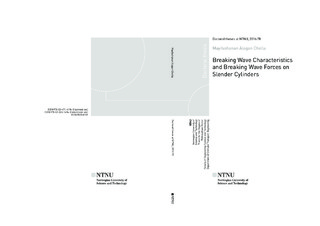Breaking Wave Characteristics and Breaking Wave Forces on Slender Cylinders
Abstract
Offshore wind farms have become an increasingly important source of clean and
renewable energy. Most recent offshore wind farms are deployed close to the coast
in shallow waters. One of the major factors influencing the initial investment of this
technology is the design of the substructure and foundation. The physical processes
associated with the non-linear shallow water hydrodynamics are rather complex since
the wave motion is strongly influenced by the seabed. Breaking waves exert significant
hydrodynamic loading on offshore wind turbine substructures and these impulsive loads
of short duration can cause permanent structural damage.
Wave impact force characteristics greatly depend on the evolution of free surface
profiles and wave height, changes in velocities, and geometric properties associated with
the breaking process. Understanding hydrodynamic loads from breaking waves has many
design-related implications for structures employed in shallow and intermediate waters.
Although extensive experimental, theoretical and numerical research has been carried
out on modelling the breaking wave forces, the breaking mechanism and their wave
impact characteristics are not yet fully understood due to many parameters involved in
the complex physical processes. The main aim of the present research was to investigate
wave breaking in shallow waters and breaking wave forces on slender cylinders.
The open source CFD model REEF3D has been used for modelling wave breaking
and computing wave breaking forces on slender cylinders in shallow waters. The
model is based on the Reynolds-Averaged Navier-Stokes (RANS) equations together
with the level set method for the free surface and the k − ω model for the turbulence.
Numerical experiments on wave breaking on sloping sea beds and submerged structures
are performed in a three-dimensional wave tank and breaking wave forces on slender
cylinders are evaluated. Moreover, the numerical model is thoroughly validated against
the experimental measurements for each case individually. First, the characteristics
and geometric properties of wave breaking over slopes and submerged structures for
different environmental parameters are examined. Comparison of the hydrodynamic
characteristics and geometric properties of spilling and plunging breakers are also presented and discussed. Breaking wave forces on slender cylinders are evaluated for
solitary and periodic waves. For both cases, the influence of the relative cylinder location
with respect to the breaking point on the breaking wave forces is investigated for different
incident wave characteristics.
The numerical results for different cases are consistent with previous studies. A
strong dependence of water depth, offshore wave steepness, and seabed slope on the
breaking characteristics is observed for different slopes and submerged structures.
Further, the evaluation of geometric properties of waves at breaking for different seabed
conditions and wave characteristics suggests that the application of the wave steepness
and asymmetry factors are appropriate for describing the breaker type and the wave
profile at breaking. Analysis of breaking wave forces indicates that the relative cylinder
location with respect to the breaking point has a large influence on the breaking wave
force. It is seen from the results that the characteristics and geometric properties at
breaking can be related to the wave impact forces from breaking waves. Moreover,
the prominent flow features associated with breaking waves and their interaction with
slender cylinders are reasonably well represented in the numerical simulation.
Has parts
Paper 1: Alagan Chella, Mayilvahanan; Tørum, Alf; Myrhaug, Dag. An Overview of Wave Impact Forces on Offshore Wind Turbine Substructures. Energy Procedia 2012 ;Volum 20. s. 217-226 http://dx.doi.org/10.1016/j.egypro.2012.03.022 Attribution-NonCommercial-NoDerivs 3.0 Unported (CC BY-NC-ND 3.0)Paper 2: Bihs, H. Kamath A., Alagan Chella, M., Aggarwal, A., Arntsen, Ø. A. (2015), A new level set numerical wave tank with improved density interpolation for complex wave hydrodynamics
Paper 3: Alagan Chella, Mayilvahanan; Bihs, Hans; Myrhaug, Dag; Muskulus, Michael. Breaking Characteristics and Geometric Properties of Spilling Breakers over Slopes. Coastal Engineering 2015 ;Volum 95. s. 4-19 http://dx.doi.org/10.1016/j.coastaleng.2014.09.003 The article in is reprinted with kind permission from Elsevier, sciencedirect.com
Paper 4: Alagan Chella, Mayilvahanan; Bihs, Hans; Myrhaug, Dag; Muskulus, Michael. Hydrodynamic Characteristics and Geometric properties of Plunging and Spilling Breakers over Impermeable Slopes. Ocean Modelling 2015 http://dx.doi.org/10.1016/j.ocemod.2015.11.011 The article in is reprinted with kind permission from Elsevier, sciencedirect.com
Paper 5: Alagan Chella, Mayilvahanan; Bihs, Hans; Myrhaug, Dag. Characteristics and Profile Asymmetry Properties of Waves Breaking over an Impermeable Submerged Reef. Coastal Engineering 2015 ;Volum 100. s. 26-36 http://dx.doi.org/10.1016/j.coastaleng.2015.03.008 The article in is reprinted with kind permission from Elsevier, sciencedirect.com
Paper 6: Kamath, A., Alagan Chella, M., Bihs, H., Arntsen, Ø. A. (2015), Energy transfer due to shoaling and decomposition of breaking and non-breaking waves over a submerged bar
Paper 7: Alagan Chella, Mayilvahanan; Bihs, Hans; Myrhaug, Dag; Muskulus, Michael. Breaking Solitary Waves and Breaking Wave Forces on a Vertically Mounted Slender Cylinder over an Impermeable Sloping Seabed. Journal of Ocean Engineering and Marine Energy 2016
Paper 8: Kamath, A., Alagan Chella, M., Bihs, H., Arntsen, Ø. A. (2015), Breaking wave interaction with a vertical cylinder and the effect of breaker location
Paper 9: Bihs, Hans; Kamath, Arun; Alagan Chella, Mayilvahanan; Arntsen, Øivind Asgeir. Breaking wave interaction with tandem cylinders under different impact scenarios. Journal of waterway, port, coastal, and ocean engineering 2016 http://dx.doi.org/10.1061/(ASCE)WW.1943-5460.0000343
